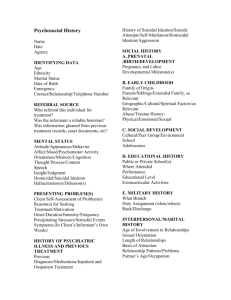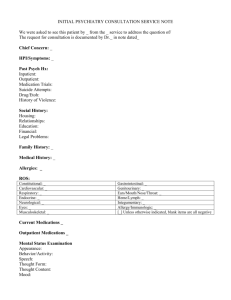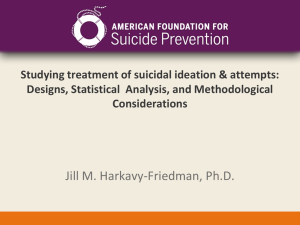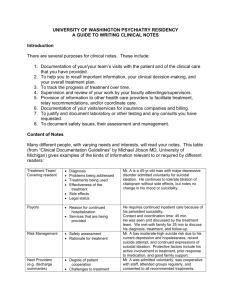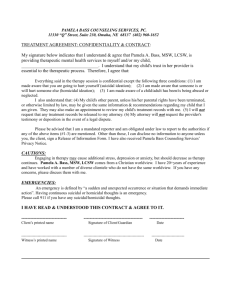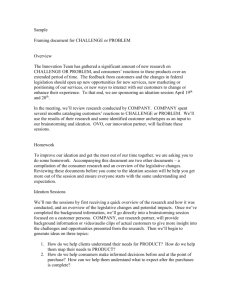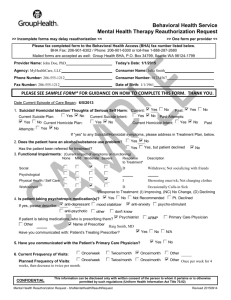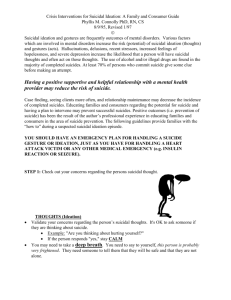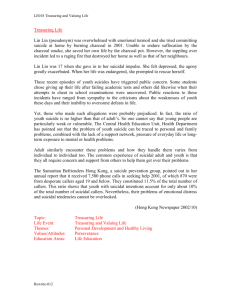OConnorNoyce2008STORRE
advertisement
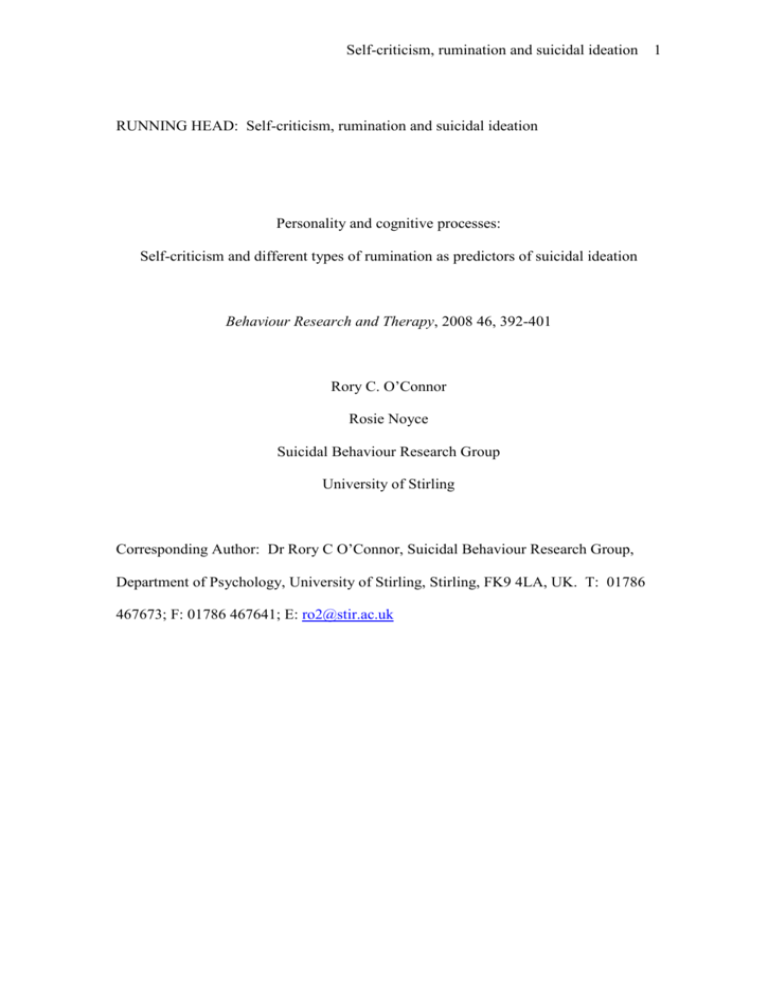
Self-criticism, rumination and suicidal ideation RUNNING HEAD: Self-criticism, rumination and suicidal ideation Personality and cognitive processes: Self-criticism and different types of rumination as predictors of suicidal ideation Behaviour Research and Therapy, 2008 46, 392-401 Rory C. O’Connor Rosie Noyce Suicidal Behaviour Research Group University of Stirling Corresponding Author: Dr Rory C O’Connor, Suicidal Behaviour Research Group, Department of Psychology, University of Stirling, Stirling, FK9 4LA, UK. T: 01786 467673; F: 01786 467641; E: ro2@stir.ac.uk 1 Self-criticism, rumination and suicidal ideation 2 Abstract Self-criticism and rumination have been related to suicidality. In the present study, we investigated the extent to which different types of rumination (brooding and reflection) mediate the relationship between self-criticism and suicidal ideation. Two hundred and thirty two healthy adults completed a range of psychological inventories at Time 1 and were followed up approximately three months later (Time 2). Brooding was more strongly associated with suicidal ideation than reflection. Hierarchical regression analyses confirmed that among those who completed measures at both time points, brooding rumination fully mediated the self-criticism–time 2 suicidal ideation relationship. Reflection did not mediate the self-criticism–suicidal ideation link. The findings support a growing corpus of research which highlights the utility of personality and cognitive factors in advancing our understanding of the suicidal process. The theoretical and clinical implications are discussed. KEY WORDS: suicidal; diathesis; mediation; psychopathology; prospective Self-criticism, rumination and suicidal ideation 3 Research on personality and cognition has identified a number of factors implicated in the etiology and course of suicidality (see Brezo, Paris & Turecki, 2006; Ellis, 2006 for reviews). These factors include problem-solving deficits, memory and thinking biases, negative cognitive style, neuroticism, impulsivity and hopelessness (Williams & Pollock, 2002). A better understanding of how these factors relate to suicidality is crucial to the development of treatment interventions. More recently, however, self-criticism and rumination have received attention as predictors of suicidal risk (see O’Connor, 2007; Morrison & O’Connor, 2007a for reviews). The research linking trait self-criticism to suicidality has been grounded within the broader perfectionism–suicidality literature wherein there is growing consensus that selfcritical evaluative concerns perfectionism, a higher order factor, defined as “overly critical evaluation of one’s own behaviour, an inability to derive satisfaction from successful performance and chronic concerns about others’ criticism and performance” is a risk factor for suicidality (Dunkley, Blankstein, Masheb, & Grilo, 2006; see also Shafran, Cooper & Fairburn, 2003). Indeed, some have suggested that self-criticism, a key component of self-critical evaluative concerns perfectionism, defined as excessive self-evaluative concerns coupled with high standards and the need for recognition (Blatt, 1995, 1990) is the active ingredient in the perfectionism–distress relationship. However, no research to date has investigated potential mechanisms which may link self-criticism to suicidal risk. Therefore, a central aim of the present study was to investigate one potential mechanism which may account for this relationship. The mechanism under consideration here was rumination, defined as “the extent to which individuals repeatedly focus on the causes, meanings, and consequences of their negative mood” (Miranda & Nolen-Hoeksema, 2007). In short, we aimed to investigate whether there is an indirect effect of self-criticism through rumination to suicidal ideation. Self-criticism, rumination and suicidal ideation 4 Over the past 15 years, the evidence base concerning the role of rumination in psychopathology has grown considerably; it has been implicated in mood disorders, particularly depression (e.g., Nolen-Hoeksema, McBride, & Larson, 1997) but more recently in the prediction of suicidality (Miranda & Nolen-Hoeksema, 2007; O’Connor, O’Connor, Marshall, 2007; Smith, Alloy & Abramson, 2006). For example, Smith and colleagues (2006) reported that rumination, as assessed by the Ruminative Responses Scale (RRS) of the Response Styles Questionnaire (RSQ; Nolen-Hoeksema & Morrow, 1991), predicted the presence and duration of suicidal ideation over 2.5 years. It is not surprising that rumination is involved in the suicidal process given that it interferes with social problem-solving (e.g., Watkins & Baracaia, 2002) which in turn increases suicidal risk (e.g, Williams, Barnhofer, Crane, & Beck, 2005). Types of Rumination: Reflection and Brooding In an attempt to specify the active types of rumination, Treynor, Gonzalez & NolenHoeksema (2003) performed secondary analyses of data from Nolen-Hoeksema, Larson & Grayson (1999) and identified two distinct aspects of rumination which explained the relationship between rumination and depression (separate from those items which were concerned with ruminating about the symptoms of depression). The first, reflection, is defined as “purposeful turning inward to engage in cognitive problem-solving to alleviate one’s depressive symptoms” (Treynor et al., 2003, p.256). Whereas the second factor, brooding, reflects “passive comparison of one’s current situation with some unachieved standard” (Treynor et al., 2003, p.256) or dwelling on the negative consequences of one’s mood (Miranda & Nolen-Hoeksema, 2007). Although there is evidence for a differential relationship between brooding/reflection and depression (e.g., Fresco, Frankel, Mennin, Turk, & Heimberg, 2002; Treynor et al., 2003) to our knowledge only three studies have looked at brooding and/or reflection within the context of suicidality. The first, a case- Self-criticism, rumination and suicidal ideation 5 control study (Crane, Barnhofer & Williams, 2007), compared three groups of participants with a history of depression (i.e., non-suicidal group versus suicidal ideator group versus suicidal attempter group) on their responses on the RRS. They reported that suicidal ideators and attempters reported reduced reflection compared to the non-suicidal group but they did not show increased brooding. In addition, the groups also differed in terms of the balance of the two factors. Suicidal attempters endorsed brooding more strongly than reflection whereas the non-suicidal group endorsed reflection more strongly than brooding. Second, in a short-term follow-up, O’Connor et al. (2007, Study two) reported that brooding predicted suicidal ideation at two months, however this study did not measure reflection. Finally, Miranda and Nolen-Hoeksema (2007) examined brooding and reflection as predictors of suicidal ideation in a community sample at baseline and at 1 year follow-up. They found that brooding was more strongly correlated with degree of ideation at baseline than was reflection. However, both brooding and reflection predicted suicidal ideation at the 1 year follow-up after controlling for demographics and baseline ideation. The present study Integrating the findings of the three latter studies with those concerning self-criticism, in the present study, we explored the relationships between brooding, reflection, selfcriticism and suicidal ideation in a sample of healthy participants at baseline and three months later (time 2). As the main aim of the present study was to test empirical hypotheses rather than to determine clinical outcome per se, we chose a relatively short follow-up period (i.e., 3 months) to minimize participant attrition between Time 1 and Time 2 (similar to Spirito et al., 2003; O’Connor et al., 2007). In the light of the mixed findings, our principal research question was to determine the extent and direction of the relationship between reflection/brooding and time two suicidal ideation. However, consistent with Miranda and Nolen-Hoeksema (2007), we tentatively Self-criticism, rumination and suicidal ideation 6 hypothesized that brooding would be more strongly related to suicidal ideation (at both time points) than reflection (hypothesis 1). In addition, as outlined earlier, we hypothesized that rumination would account for (mediate) the relationship between selfcriticism and time 2 suicidal ideation independent of baseline suicidal ideation. Consistent with the hypothesis one, we posited that brooding would be a stronger mediator of the selfcriticism–suicidal ideation relationship than reflection (hypothesis 2). Method Participants and Procedure We recruited 232 healthy adults from a British university and via convenience sampling from the general population. There were 170 females and 62 males with an overall mean age of 25.98 years (SD=14.36). The men (M=29.9, SD=18.2) were significantly older than the women (M=24.5, SD=12.5), t(230)=2.57, p<.05. At Time 1, all participants completed a range of psychological measures, as outlined below. The order of presentation of these measures was counterbalanced. At Time 2, approximately 3 months later (M=11.4 weeks, SD=4.6), participants were contacted again and asked to complete the suicide ideation subscale of the Suicide Probability Scale (Cull & Gill, 1988). The Suicide Probability Scale was included as it is a recognized predictor of suicide risk (e.g., Larzelere, Smith, Batenhorst, & Kelly, 1996; Witte, Fitzpatrick, Joiner, Bradley, & Schmidt, 2005) and it has been shown to be sensitive to changes in suicidality (e.g., Rudd, Rajab, Orman, Stulman, Joiner, & Dixon, 1996). To maximize follow-up, we made concerted efforts to contact all participants via post, email and telephone. Baseline Measures Suicidal Ideation. Suicidal ideation was assessed using the suicidal ideation subscale of the Suicide Probability Scale (Suicidal ideation-T1; Cull & Gill, 1988). The subscale is comprised of 8 items pertaining to suicidal cognitions, negative affect, and presence of a Self-criticism, rumination and suicidal ideation 7 suicide plan (e.g., “I think of suicide”). Respondents are asked to indicate how often they feel the statement applies to them from none or a little of time (1) to most or all of the time (4). The scale has good reliability and validity (Cull & Gill, 1988). Cronbach’s =.90. Depression. Depression was assessed via the Centre for Epidemiological Studies Depression Scale (CES-D) which is a 20-item measure for use in the general population (Radloff, 1977). Participants are required to rate on a four point scale from rarely or none of the time (0) to most or all of the time (3) how often they have felt or behaved like each of the statements during the past week (e.g., “I felt depressed”). Higher scores represent elevated depressive symptomatology. The scale is reliable and valid (Radloff, 1991). Internal consistency was good (=.93). Self-Criticism. Self-criticism was measured via the McGill Revised Depressive Experiences Questionnaire (Santor, Zuroff & Fielding, 1997). As the focus of the present study was on self-criticism (not dependency), only those items (n=30) which loaded on the self-criticism factor were included in the study (see Santor et al., 1997 for details). Respondents are asked to indicate the extent to which they agree/disagree with statements concerning personal characteristics and traits (e.g., “I tend to be very critical of myself”) from strongly disagree (1) to strongly agree (7). Internal consistency for the scale was very good (=.82). Rumination. The Ruminative Responses Scale (RRS) of the Response Styles Questionnaire (RSQ; Nolen-Hoeksema & Morrow, 1991) was employed to measure rumination. It consists of 22 items which record the extent to which individuals repeatedly focus on the causes, meanings, and consequences of their negative mood. A recent factor analysis (Treynor et al., 2003) has identified two separate subscales. The first, brooding, consists of five items that assess the extent to which individuals passively focus on the reasons for their distress (e.g., “how often do you think about a recent situation, wishing it Self-criticism, rumination and suicidal ideation 8 had gone better?”). Reflective pondering or reflection is the second scale which also consists of five items that assess the degree to which individuals engage in cognitive problem-solving to relieve their distress (e.g., “How often do you analyze recent events to try to understand why you are depressed”). Respondents are asked to indicate how often they think or do each item from almost never (1) to almost always (4). Both subscales are reliable (=.82 and .85 for brooding and reflection, respectively). Follow-up Measure Participants completed the suicide ideation subscale of the Suicide Probability Scale (Suicidal ideation-T2; =.87) at Time 2. Statistical Analyses First, we describe the sample (correlations, means and SDs) and then we present hierarchical regression analyses with those participants who completed measures at Time 1 and Time 2, to probe the key hypotheses. We adhered to Baron and Kenny (1986) and Kenny, Kashy, & Bolger’s (1998) guidelines on testing for mediation. In addition, as age and sex differences exist in respect of affect and suicidality (O’Connor & Sheehy, 2000), we controlled for their potential effects in the multivariate analyses. Results Of the initial sample, 66% (n=153) completed measures at both time points, at Time 1 (Time 1) and Time 2 (T2), approximately three months later. Our follow-up rate compares favorably to other studies in the field (e.g., Walker, Joiner & Rudd, 2001; Wingate, Van Orden, Joiner, Williams, & Rudd, 2005). There was no significant sex difference between those who did/did not complete Time 2, 2 (1)=.55, ns, but those who did not complete the T2 measures were significantly younger, t(230)=2.44, p<.05. With one exception (brooding), the groups did not differ significantly on the T1 variables (i.e., suicidal ideation, self-criticism, reflection; range: t(230)=.47 to 1.9, ns). Those who completed Self-criticism, rumination and suicidal ideation 9 measures at Time 2 reported significantly lower levels of brooding compared with those who did not do so, t(230)=2.07, p<.05. Participants reported significantly lower levels of suicidal ideation at T2 (M=9.44, SD=2.63) compared with T1 (M=9.02, SD=2.11), t(152)=2.65, p<.01. [Insert Table 1 about here] Correlations and Hierarchical Regression Analyses As the focus of the study is on those who completed measures at both time points, all forthcoming analyses are circumscribed to these individuals (n=153). Zero-order correlations, means and standard deviations for the baseline and outcome variables are presented in Table 1. As expected, suicidal ideation (at T1 and T2) was positively correlated with self-criticism, brooding and reflection. Although brooding and reflection were both correlated with suicidal ideation, the association between brooding and time 2 suicidal ideation was stronger, r(153)=.511, p<.001, than that between reflection and time 2 suicidal ideation, r(153)=.368, p<.001, Zdiff(150)=2.39, p<.01. A similar trend was also evident for their relationships with time 1 suicidal ideation, albeit the difference failed to meet conventional significance, Zdiff(150)=1.41, p=.08; r(153)=.502, p<.001 and r(153)=.418, p<.001 for brooding and rumination respectively. Younger participants reported higher levels of suicidal ideation, reflection, brooding and self-criticism. [Insert Table 2 about here] Brooding and Reflection as Predictors of Time 2 Suicidal Ideation To further test hypothesis 1, we conducted a hierarchical regression analysis wherein we examined the relative influence of brooding and reflection in the prediction of suicidal ideation at time 2 whilst adjusting for age, sex and baseline suicidal ideation. As summarised in Table 2, we entered age, sex and baseline suicidal ideation at step 1, with reflection and brooding entered simultaneously at step 2. Adjusting for the step 1 Self-criticism, rumination and suicidal ideation 10 variables, brooding, =.239, t(152)=2.97, p<.01, but not reflection, =-.019, t(152)=-.25, ns, independently predicted time 2 suicidal ideation. [Insert Table 3 about here] Testing Rumination as a Mediator of the Self-Criticism–Suicidal Ideation Relations Following the procedure outlined by Baron and Kenny (1986) and Kenny et al. (1998), to test for mediation, two hierarchical regressions were performed. In each analysis, brooding and reflection are considered simultaneously, thereby investigating their independent effects. According to Kenny et al. (1998), mediation (i.e., the mediator carries the influence of the IV to the DV) is demonstrated when the following conditions are met: (1) the independent variable (i.e., self-criticism) affects the mediator (i.e., brooding or reflection); (2) the independent variable affects the dependent variable (i.e., T2 suicidal ideation); (3) the mediator affects the dependent variable when the independent variable is controlled for and; (4) full mediation is confirmed when the association between the independent variable and dependent variable is reduced to non-significance after the effect of the mediator is controlled for. If conditions 1-3 are met partial mediation is indicated. We conducted a Sobel test to determine the significance of the indirect effect (see Preacher & Hayes, 2004) whilst controlling for covariates. To ensure a rigorous test of the self-criticism–rumination–T2 suicidal ideation relationship, we controlled for the effects of sex, age and baseline suicidal ideation in the first step of the hierarchical regression analysis, before investigating Kenny and colleagues’ conditions for mediation. Next, self-criticism was entered as a predictor of time 2 suicidal ideation at step 2, in order to test condition 2, followed by brooding and reflection at step 3, to test conditions 3 and 4. The mediator (i.e., brooding or reflection) was also separately regressed onto self-criticism, in order to test condition 1. The outputs for steps 1–3 are Self-criticism, rumination and suicidal ideation 11 presented in Table 3 whereas the mediator–predictor regression findings are described below. As is evident in Table 3, after controlling for sex, age, and baseline suicidal ideation, self-criticism is a significant predictor of T2 suicidal ideation at step 2, =.152, t(152)=2.26, p<.05, thereby confirming condition 2. At step 3, brooding is a significant predictor of T2 suicidal ideation, =.216, t(152)=2.38, p<.05, and the relationship between self-criticism and T2 suicidal ideation is reduced to non-significance, =.044, t(152)=.55, ns. In addition, self-criticism independently effects brooding, =.405, t(152)=6.28, p<.001, therefore conditions 1-4 are met. A Sobel test confirmed a significant reduction in selfcriticism's relationship with time 2 suicidal ideation, z=2.23, p<.05. It is also noteworthy that, not only does brooding act as a mediator but that brooding and self-criticism explain an additional 4% of variance in suicidal ideation (Cohen’s f2 =.08) which represents a small-to-moderate effect size (Cohen, 1992). Finally, although reflection was correlated with suicidal ideation, it hasd no effect on suicidal ideation at time 2 independent of brooding and baseline suicidal ideation (=-.023, t(152)=-.297, ns; see Table 3). In short, it did not mediate the self-criticism–suicidal ideation relationship. Discussion The study yielded considerable evidence for the role of rumination and self-criticism in the prediction of suicidal ideation. Taking the hypotheses/research questions in turn. With respect to the principal research question, to determine the extent and direction of the relationship between reflection/brooding and time 2 suicidal ideation, the hierarchical regression analysis adjusting for baseline ideation, age and sex was unambiguous: brooding but not reflection independently predicted time 2 suicidal ideation, such that higher levels of brooding were associated with higher levels of ideation. There was also Self-criticism, rumination and suicidal ideation 12 support for the first hypothesis, that brooding would be more strongly related to suicidal ideation than reflection. The correlational analyses revealed that the relationship between brooding and time 2 suicidal ideation was significantly stronger than the correlation between reflection and time 2 ideation. A similar, albeit non-significant, trend was also evident with respect to these relationships with time 1 ideation. Besides, the findings from the regression analyses further highlighted the dominant brooding–suicidal ideation relationship compared with the same reflection relationship. Finally, the present results also supported the second hypothesis. Not only is brooding a stronger mediator of the selfcriticism–time 2 suicidal ideation relationship but our data suggest that brooding fully mediates this pathway with reflection not accounting at all for the indirect effect of selfcriticism on suicidal ideation. This establishes rumination as one possible mechanism to account for the relationship between self-criticism and suicidality. The present findings extend the previous research in a number of key respects. Consistent with Miranda and Nolen-Hoeksema (2007) and O’Connor et al. (2007), we have yielded evidence to further highlight the deleterious effect of brooding in the prediction of suicidal ideation. What is more, we have addressed one of the limitations identified by Miranda and Nolen-Hoeksema (2007) in their study. Whereas they employed a categorical measure of suicidal ideation (i.e., presence or absence of suicidal ideation in the previous month), we employed a continuous measure thereby affording the opportunity to look at suicidal ideation as a dimensional construct. Furthermore, we also believe that our findings are not inconsistent with Miranda and Nolen-Hoeksema’s conclusion that both brooding and reflection are predictive of suicidal ideation. The fact that the present study only yielded correlational evidence of a relationship between reflection and suicidal ideation may suggest that reflection has a markedly weaker effect size than that of brooding. In support of this viewpoint, it is important to highlight that Miranda and Nolen-Hoeksema’s Self-criticism, rumination and suicidal ideation 13 study consisted of more than 1100 participants thereby facilitating the identification of relatively small statistical effects. Contrary to Crane et al.’s (2007) study, we found no evidence for the protective effects of reflection. There are a number of possible explanations for this null finding. First, in the former study, the protective effects of reflection were largely accounted for by the difference between the non-suicidal group and the suicide attempters. As the present study was circumscribed to suicide ideators and was not a case-control study, direct comparison is limited –and the divergent findings may be an artefact of the sample composition. Moreover, our study and that of Miranda and Nolen-Hoeksema’s was concerned with concurrent and prospective suicidal ideation. Conversely, Crane et al.’s study focused on history of suicidal ideation and behaviour, perhaps the relationship between rumination and suicidality differs as a function of suicidal status. It may also be that the cognitive problem-solving which characterises reflection is more pertinent in suicidal attempters than ideators. Although Crane and colleagues’ study reported no difference in brooding between their three groups, visual inspection of the mean scores suggests a slight trend in the predicted direction– the relatively large SDs in two of the groups may explain the absence of a significant difference. The present findings emphasize the importance of identifying personality factors to better understand the course of suicidality. In short, our data suggest that brooding may, in part, account for the relationship between self-criticism and suicidal ideation. Given that brooding is characterised by self-critical pondering the strength of its relationship with trait self-criticism is, perhaps, not surprising. It is worth noting, however, that as our study was a prospective, correlational design, future research ought to attempt to experimentally manipulate self-criticism to determine whether there is an associated change in brooding. If so, the potential for suicide prevention is considerable. Nonetheless, the current data Self-criticism, rumination and suicidal ideation 14 reinforce the view that certain personality factors and cognitive processes increase one’s vulnerability to suicidal ideation. The findings are consistent with the Cry of Pain model of suicidal behaviour (Williams, 2001; O’Connor, 2003) which argues that the conjoint effects of stressors which result in feelings of defeat from which there is no apparent escape (i.e., entrapment) are especially potent in the etiology of suicidal behaviour. To this end, our findings suggest that selfcriticism and brooding may act to elevate suicide risk by increasing the likelihood that one appraises a stressful situation as resulting in defeat (via high levels of self-criticism) and that this situation is inescapable (i.e., a state of entrapment; via high levels of brooding). The brooding effect is also noteworthy as it fully mediated the self-criticism–T2 suicidal ideation relationship, translating into a small-to-moderate effect size (Cohen, 1992). Indeed, following a recent critique of behavioural medicine research, Rutledge and Loh (2004) highlighted the considerable, clinical implications of small statistical effects (e.g., of aspirin). In addition, the mediation effect is worth highlighting as brooding predicts suicidal thinking three months following baseline while controlling for initial suicidal ideation, age and sex. Implications and Limitations There are also a number of clinical implications from this research. First, our data point to a specific cognitive-behavioural pathway (i.e., self-criticism–brooding–suicidal behaviour) on which a treatment intervention could be developed. Second, given that brooding accounted for all of the indirect influence of self-criticism on suicidal ideation, resources should be particularly focussed on brooding. Therefore, if, as is likely, it is more difficult to modify trait self-criticism, interventions which target brooding should neutralise, in part, the negative effects of self-criticism thereby reducing suicide risk. Self-criticism, rumination and suicidal ideation 15 Although the present study had a number of strengths, two potential limitations require comment. First, those who completed the measures at time 2 reported significantly lower levels of brooding compared to those who did not. Rather than being a limitation, we would argue that this adds to the brooding effect, as one may posit that if all participants had completed measures at time 2 the relationship between brooding and suicidal ideation would have been stronger. Second, although we examined suicidal ideation, it is not clear whether these findings would generalise to suicide attempters or to a clinical sample. Moreover, despite employing a prospective study design, we were unable to disentangle the causal relations between variables. Therefore, future research could usefully address this by conducting experimental studies to determine whether, for example, the experimental enhancement of brooding leads to decreased suicidality over time. It would also be useful to determine the extent to which other personality and cognitive factors are implicated in the etiology of suicidality. Given the equivocal findings for reflection in the literature, we would urge further research across different timeframes and population to tease out the extent to which it is adaptive/maldaptive and under which conditions it has its effect. Although we focused on the three months follow-up, it would be clinically and empirically useful to extend the follow-up period. For example, does brooding mediate the relationship between self-criticism and suicidal ideation over the longer term; does it predict repetitive self-harm? Conclusion This is the first study to demonstrate that brooding mediates the self-criticism–suicidal ideation relationship. Brooding was more strongly related to suicidal ideation than reflection. The findings point to a potential cognitive-behavioural pathway which ought to be targeted in the development of treatment interventions. Prevention efforts to tackle Self-criticism, rumination and suicidal ideation 16 suicidality would benefit from a better understanding of how personality factors and cognitive processes relate to one another as well as to suicidal ideation and behaviour. References Baron, R.A., & Kenny, D.A. (1986). The moderator-mediator variable distinction in social psychological research: Conceptual, strategic and statistical considerations. Journal of Personality and Social Psychology, 51, 1173-1182. Blatt, S.J. (1995). The destructiveness of perfectionism: Implications for the treatment of depression. American Psychologist, 50, 1003-1020. Blatt, S.J. (1990). Interpersonal relatedness and self-definition: Two personality configurations and their implication for psychopathology and psychotherapy. In J.L. Singer (Ed.)., Repression and dissociation: Implications for personality theory, psychopathology and health (pp.299-335). Chicago: University of Chicago Press. Brezo, J.; Paris, J.; Turecki, G. (2006). Personality traits as correlates of suicidal ideation, suicide attempts, and suicide completions: a systematic review. Acta Psychiatrica Scandinavica, 113, 180-206 Cohen, J. (1992). A power primer. Psychological Bulletin, 112, 103-116. Crane, C., Barnhofer, T., & Williams, J.M.G. (2007). Reflection, brooding and suicidality: A preliminary study of different types of rumination in individuals with a history of major depression. British Journal of Clinical Psychology, in press. Cull, J.G., & Gill, W.S. (1988). Suicide Probability Scale (SPS) manual. Los Angeles: Western Psychological Services. Dunkley, D.M., Blankstein, K.R., Masheb, R.M., & Grilo, C.M. (2006). Personal standards and evaluative concerns dimensions of “clinical” perfectionism: A reply to Shafran et al. (2002, 2003) and Hewitt et al. (2003). Behaviour Research and Therapy, 44, 63-84 Self-criticism, rumination and suicidal ideation 17 Ellis, T.E. (2006). Cognition and Suicide: Theory, Research and Therapy. Washington, DC: American Psychological Association. Fresco, D.M., Frankel, A.N., Mennin, D.S., Turk, C.L., & Heimberg, R.G. (2002). Distinct and overlapping features of rumination and worry: The relationship of cognitive production to negative affective states. Cognitive Therapy and Research, 26, 179-188. Kenny, D.A., Kashy, D.A., & Bolger, N. (1998). Data analysis in social psychology. In D.T. Gilbert, S.T. Fiske, & G. Lindzey (Eds.), The handbook of social psychology. McGraw-Hill Companies. Boston: Massachusetts. Larzelere, R.E., Smith, G.L., Batenhorst, L.M., & Kelly, D.B. (1996). Predictive validity of the suicide probability scale among adolescents in group home treatment. Journal of the American Academy of Child and Adolescent Psychiatry, 35, 166-172. Miranda, R., & Nolen-Hoeksema, S. (2007). Brooding and reflection: Rumination predicts suicidal ideation at 1 year follow-up in a community sample. Behaviour Research and Therapy, in press. Morrison, R., & O’Connor, R.C. (2007). Rumination and Suicidality: A systematic review. Submitted. Nolen-Hoeksema, S., Larson, J., & Grayson, C. (1999). Explaining the gender difference in depressive symptoms. Journal of Personality and Social Psychology, 77, 10611072. Nolen-Hoeksema, S., McBride, A., & Larson, J. (1997). Rumination and psychological distress among bereaved parents. Journal of Personality and Social Psychology, 61, 105-121. Nolen-Hoeksema, S., & Morrow, J. (1991). A prospective study of depression and posttraumatic stress symptoms after a natural disaster: The 1989 Loma Prieta earthquake. Journal of Personality and Social Psychology, 61, 115-121. Self-criticism, rumination and suicidal ideation 18 O'Connor, R.C. (in press). The relations between perfectionism and suicidality: A systematic review. Suicide and Life-Threatening Behaviour. O’Connor, R.C. (2003). Suicidal behaviour as a cry of pain: Test of a psychological model. Archives of Suicide Research, 7, 297-308. O’Connor, R.C., & Cassidy, C. (2007). Predicting hopelessness: The interaction between optimism/pessimism and specific future expectancies. Cognition and Emotion, 21, 596-613 O'Connor, D.B. , O'Connor, R.C., Marshall, R. (2007). Perfectionism and Psychological Distress: Evidence of the mediating effects of rumination. European Journal of Personality, 21, 429-452. O'Connor, R.C., Whyte, M.C., Fraser, L., Masterton, G., Miles, J., & MacHale, S. (2007). Predicting short-term outcome in well-being following suicidal behaviour: The conjoint effects of social perfectionism and positive future thinking. Behaviour Research and Therapy, 45, 1543-1555. O’Connor, R., Sheehy, N. (2000). Understanding Suicidal Behaviour. BPS Blackwell: Oxford. Preacher, K.J., & Hayes, A.F. (2004). SPSS and SAS procedures for estimating indirect effects in simple mediational models. Behaviour Research Methods, Instruments and Computers, 36, 717-731. Rudd, M.D., Rajab, M.H., Orman, D.T., Stulman, D.A., Joiner, T., & Dixon, W. (1996). Effectiveness of an outpatient intervention targeting suicidal young adults: Preliminary results. Journal of Consulting and Clinical Psychology, 64, 179-190. Rutledge, T., & Loh, C. (2004). Effect sizes and statistical testing in the determination of clinical significance in behavioural medicine research. Annals of Behavioural Medicine, 27, 138-145. Self-criticism, rumination and suicidal ideation 19 Santor, D.A., Zuroff, D.C., & Fielding, A. (1997). Analysis and revision of the Depressive Experiences Questionnaire: Examining scale performance as a function of scale length. Journal of Personality Assessment, 69, 145-163. Shafran, R., Cooper, Z., & Fairburn, C G. (2003). Clinical perfectionism" is not "multidimensional perfectionism": A reply to Hewitt, Flett, Besser, Sherry & McGee Behaviour Research and Therapy, 41, 1217-1220 Smith, J.M., Alloy, L.B., & Abramson, L.Y. (2006). Cognitive vulnerability to depression, rumination, hopelessness and suicidal ideation: Multiple pathways to self-injurious thinking. Suicide and Life-Threatening Behaviour, 36, 443-454. Spirito, A., Valeri, S., Boergers, J., & Donaldson, D. (2003). Predictors of suicidal behaviour in adolescents following a suicide attempt. Journal of Clinical Child and Adolescent Psychology, 32, 284-289. Treynor, W., Gonzalez, R., & Nolen-Hoeksema, S. (2003). Rumination reconsidered: A psychometic analysis. Cognitive Therapy and Research, 27, 247-259. Williams, J.M.G., & Pollock, L.R. (2002). Psychological aspects of the suicidal process. In Kees van Heeringen, (2002). Understanding suicidal behaviour. Chichester: Wiley. Walker, R.L., Joiner, T.E., Rudd, M.D. (2001). The course of post-crisis suicidal symptoms: how and from whom is suicide ‘cathartic’? Suicide and Life-Threatening Behaviour, 31, 144-152. Watkins, E., & Baracaia, S. (2002). Rumination and social problem-solving in depression. Behaviour Research and Therapy, 40, 1179-1189. Williams, J.M.G. (2001). Suicide and Attempted Suicide. London, UK: Penguin. Williams, J.M.G., Barnhofer, T., Crane, C., & Beck, A.T. (2005). Problem-solving deteriorates following mood challenge in formerly depressed patients with a history of suicidal ideation. Journal of Abnormal Psychology, 114, 421-431. Self-criticism, rumination and suicidal ideation 20 Wingate, L.R., Van Orden, K.A., Joiner, T.E., Williams, F.M., & Rudd, M.D. (2005). Comparison of compensation and capitalization models when treating suicidality in young adults. Journal of Consulting and Clinical Psychology, 73, 756-762. Witte, T.K., Fitzpatrick, K.K., Joiner, T.E., & Bradley Schmidt, N. (2005). Variability in suicide ideation: A better predictor of suicide attempts than intensity or duration of ideation? Journal of Affective Disorders, 88, 131-136. Self-criticism, rumination and suicidal ideation 21 Table 1 Correlations, Means and SDs for All The Study Variables for Those Who Completed Measures at T1 and T2 Age Suicidal-T1 Suicidal-T2 Depression-T1 Reflection Age Brooding Self-criticism - Suicidal-T1 -.184* - Suicidal-T2 -166* .681*** - Depression-T1 -.188* .597*** .509*** - Reflection -.208** .418*** .368*** .578*** - Brooding -.236** .502*** .511*** .720*** .638*** - Self-criticism -.174* .453*** .425*** .631*** .499*** .664*** - Mean 27.43 9.44 9.02 12.41 8.73 9.32 111.71 (SD) (15.81) (2.63) (2.11) (10.55) (3.61) (3.34) (20.52) Note. *p<.05, **p<.01, ***p<.001. Suicidal-T1=suicidal ideation at Time 1, Suicidal-T2=suicidal ideation at Time 2, Depression-T1=depression at Time 1 Self-criticism, rumination and suicidal ideation 22 Table 2 Hierarchical Regression Analysis Predicting Time 2 Suicidal Ideation from Brooding and Reflection, Adjusting for Age, Sex and Baseline Depression and Suicidal Ideation Step Step 1 Variable Age Sex Suicidal-T1 Depression-T1 at step -.042 -.064 .616*** .143 P-value for at step .488 .287 .001 .051 Age Sex Suicidal-T1 Depression-T1 Reflection Brooding -.016 -.069 .587*** -.033 .033 .250** .788 .237 .001 .714 .666 .005 R2 for step Total R2 .513*** .513*** .033** .546*** Step 2 Note. *p<.05, **p<.01, ***p<.001. Suicidal-T1=suicidal ideation at Time 1 Self-criticism, rumination and suicidal ideation 23 Table 3 Hierarchical Regression Analysis Testing the Mediating Effects of Brooding and Reflection on the Relationship between Self-criticism and Time 2 Suicidal Ideation Step Step 1 Step 2 Variable Age Sex Suicidal-T1 Depression-T1 at step -.042 -.064 .616*** .143 P-value for at step .488 .287 .001 .051 Age Sex Suicidal-T1 Depression-T1 Self-criticism -.037 -.077 .597*** .059 .156* .536 .198 .001 .479 .038 R2 for step Total R2 .513*** .513*** .014* .527*** Step 3 Age -.017 .778 Sex -.075 .203 Suicidal-T1 .582*** .001 Depression-T1 -.053 .565 Self-criticism .077 .335 Reflection .029 .706 Brooding .219* .021 .022* Note. *p<.05, ***p<.001. Suicidal-T1=suicidal ideation at Time 1 .549***
